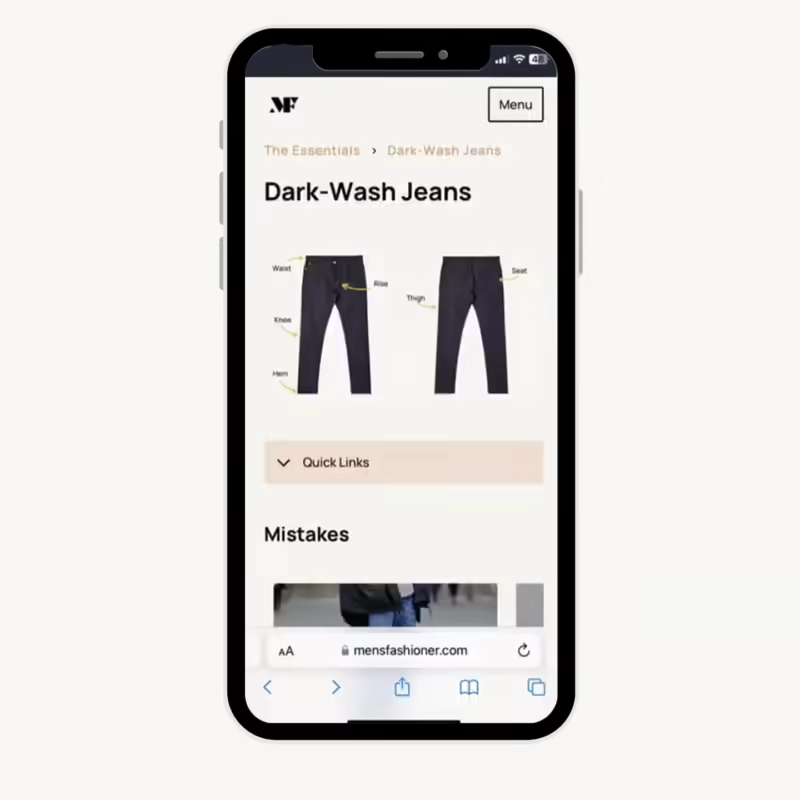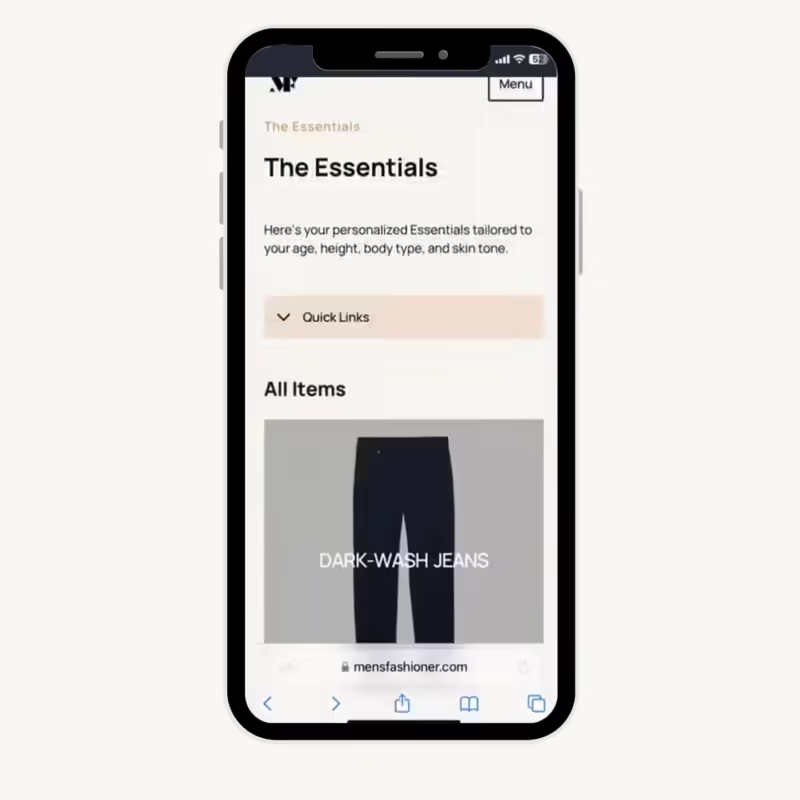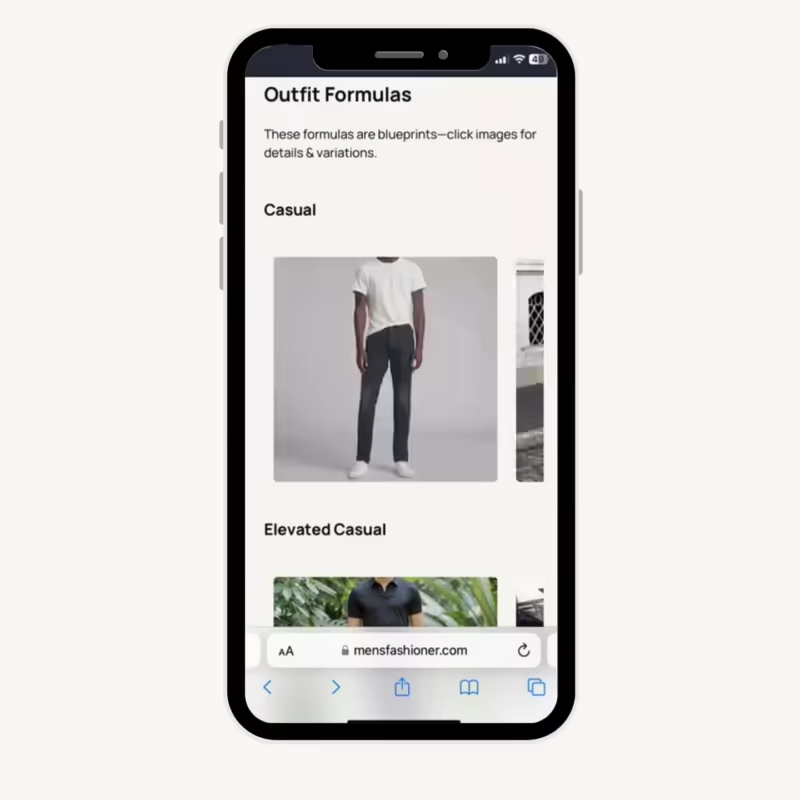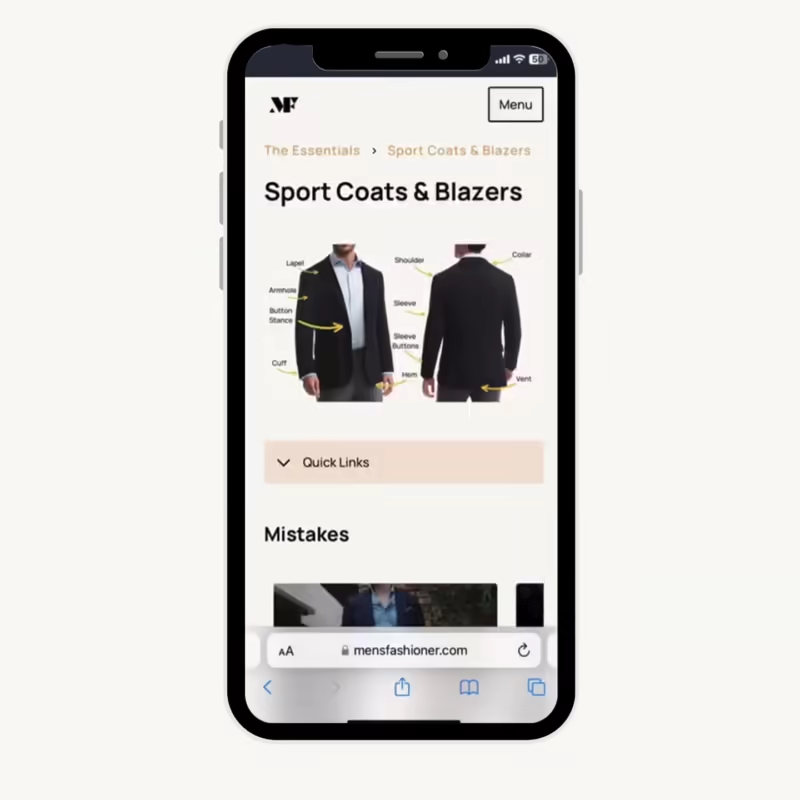
Men's Blazers & Sport Coats - The Ultimate Guide
A blazer, sport coat, or sports jacket—let’s stick with "blazer"—is a business casual essential, embodying the perfect blend of business and dressy casual.
With various styles, fabrics, and colors to choose from, finding the right one can elevate any wardrobe.
Quick Links
Frequently Asked Questions
What dress codes can I wear a blazer for?
A blazer is a versatile piece that adds sophistication and polish, making it ideal for various dress codes. It shines particularly in business casual and smart casual settings but can also work in semi-formal or elevated casual scenarios depending on how it's styled.
What are the different styles of men's blazers?
Blazers feature different vent styles (vertical slits on the back), with the double vent being the most flattering and versatile option. If unavailable, a single vent is an acceptable alternative. Avoid ventless blazers—they lack structure and style.
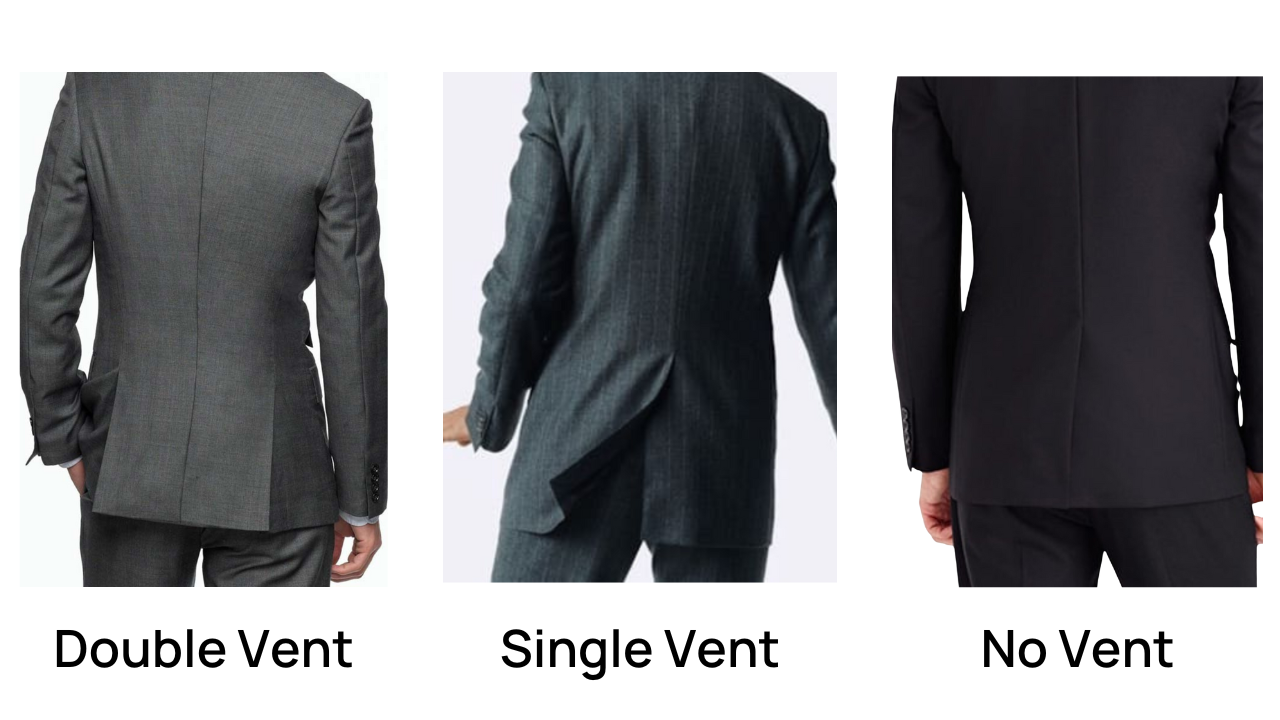
How many buttons should my blazer have?
When in doubt, stick with a two-button blazer—a timeless and versatile choice.
While three-button blazers might be trendy, they risk quickly becoming outdated, making two buttons the safer, classic option.
Should I button all the buttons on my blazer?
No, never button all the buttons on your blazer. Only button the top button, leaving the bottom one always undone.
Additionally, unbutton your blazer when sitting down for comfort and proper drape.
How can I learn more about the other must-have items for men?
The Essentials App is a comprehensive tool designed to help men build a versatile, year-round wardrobe. It offers expert guidance, personalized tips, and outfit inspiration, simplifying the process of creating a well-rounded collection of must-have items.

Blazer Mistakes Most Men Make
A blazer can elevate your style, but only if worn correctly. Avoid these common mistakes to ensure a polished look every time:
Mistaking It for a Suit Jacket: Blazers and suit jackets are different. Check the "Blazer vs. Suit Jacket" section below for details.
Choosing the Wrong Fabric Weight:
For most climates, opt for 8–10 ounces.
Hot climates: around 6 ounces.
Cold climates: above 10 ounces.
Buttoning the Bottom Button: Always leave the bottom button undone for a classic and proper fit.
Pairing a Navy Blazer with Tan Chinos: This combo often clashes. Instead, pair your blazer with jeans or wool trousers.
Wearing Jackets with Elbow Patches: These look outdated and distracting, especially if the patches contrast with the blazer.
Stick to these guidelines to effortlessly nail the blazer look.
Every Item Explained
From fit to fabric, The Essentials App explains everything about a year-round wardrobe that you need for your age, height, body type and skin tone so you'll always look age-appropriate and not like you're trying too hard.
Anatomy of a Blazer
There are a number of different parts to a blazer and it's important to know what to look for.

Shoulders
This is the measurement that should dictate the size of your blazer.
You want the shoulder seam of the blazer to line up exactly with where your shoulder bone starts to curve down towards your arm.
There should not be any pulling or divots in the fabric.
If the shoulders are too big or small, a tailor will have a hard time fixing this, and it will be very expensive (if it's even possible), so ensure they fit properly when buying your blazer.
Lapel
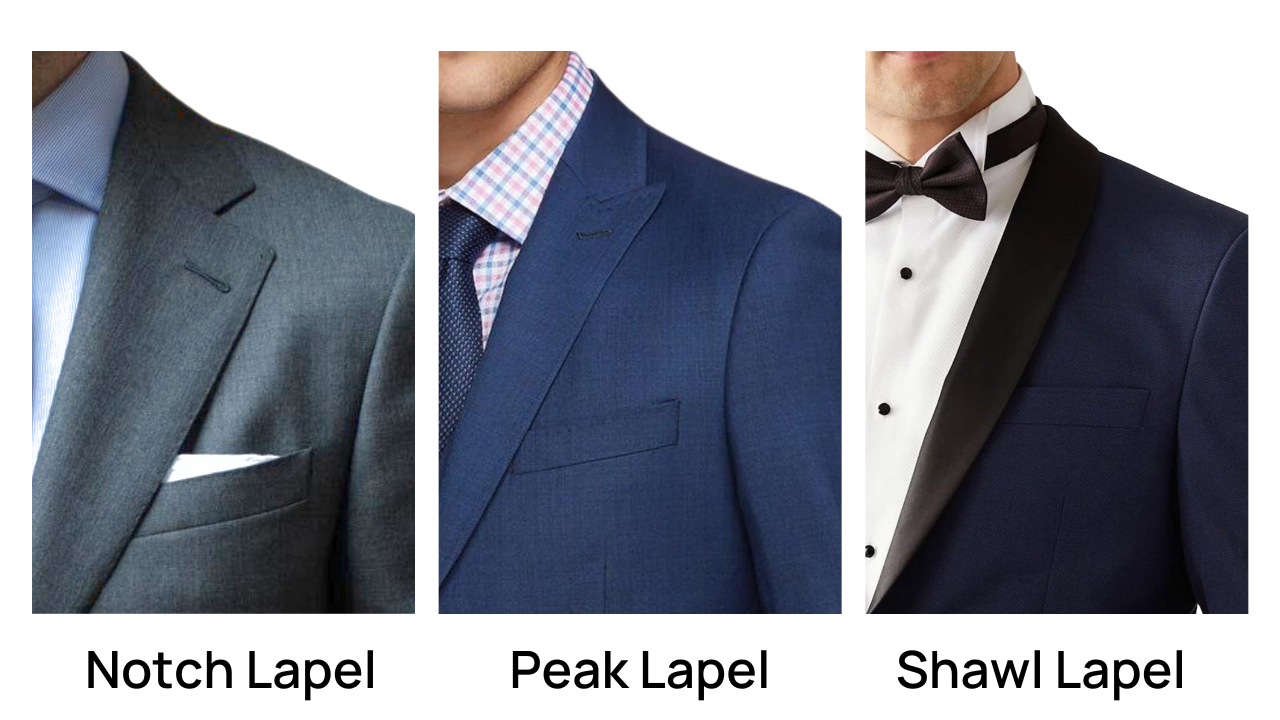
Just like your suit jacket, you're always going to want to go for a 'notch' lapel.
It's called this because it looks like a small notch has been taken out of the side of the lapel.
A peak lapel is very aggressive and doesn’t work on everybody and a shawl lapel should always be avoided.
A notch lapel is as classic and timeless as it gets.
Arm Holes
The armholes should sit high but not so high that they dig into your armpits.
They should be snug enough to avoid excess space but not so tight that they restrict movement.
Your arms should move naturally without pulling the jacket's body excessively, allowing for comfortable, normal motion.
Button Stance
Simply put, the button stance measures the placement of the buttons on the front of a jacket.
The blazer’s second button from the bottom (aka the top button) should lie just above your belly button (no more than 1 inch/2.5cm), and never below.
Otherwise, it’ll throw off your body’s proportions and you’ll look really odd.
Cuff
Proper sleeve length is key for a polished look.
The blazer sleeve should sit about 0.25 inches (0.63 cm) above the top of your hand when your arms are relaxed and palms face downward.
This allows a subtle peek of your shirt sleeve, enhancing the overall style.
Longer sleeves can be easily shortened by a tailor. However, if the sleeves are more than an inch too short, the blazer likely cannot be adjusted to fit properly.
Jacket Length
The length of your blazer will dictate how “balanced” your upper body is to your lower body.
The blazer should end around mid to lower crotch.
Mid-crotch if you’re under 5ft 9 inches (1.79m), lower than that if you’re taller than that.
A tailor can shorten your jacket up to an inch without messing up its proportions, but they can never lengthen your jacket.
Overall, you generally want this part to already be perfect when you’re buying a blazer, even off the rack.
Collar
The collar should rest against your shirt collar, which in turn should rest against the back of your neck.
All of these should touch lightly, without significant gaps in between. If there’s a gap, it’s too loose.
If there’s bunching just under the back of the jacket collar, it’s too tight or the stance of the jacket is off.
Sleeve
The sleeve of your jacket should fit comfortably over your shirt sleeve worn underneath without being overly loose or tight.
Sleeve Buttons
The majority of blazers come with decorative (non-functional) sleeve buttons.
These allow the sleeves of the blazer to fit as many arm sizes as possible.
If the buttons were functional, it would be exceedingly difficult to adjust the length of the sleeve for different arms.
The number of buttons dictates the style of the blazer.
Three-button sleeves have a more casual look while four buttons are a more traditional option.
Vent
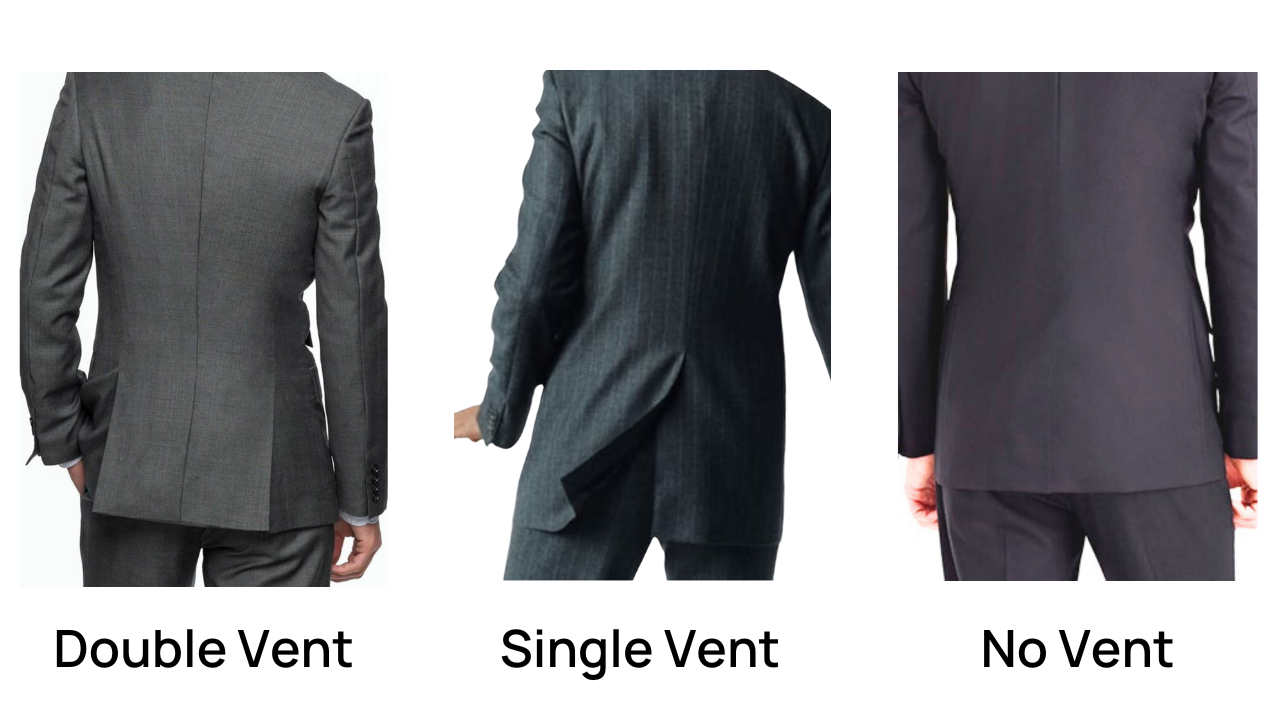
A vent is basically a vertical slit found at the back of a blazer.
Go for a blazer with a double vent.
This style of vent has been around for quite a while and is always flattering.
If you can't find a double vent, then a single vent is decent a secondary option.
Never go for a blazer without a vent – it’s a horrible look.
Blazer vs. Sports Coat
While technically different, the terms are often used interchangeably in stores.
Key Differences:
Buttons: Blazers often have metal or contrasting buttons, while sports coats typically use standard ones.
Patterns: Traditionally, sports coats are patterned, and blazers are solid-colored.
That said, these distinctions are rarely enforced in modern shopping. Stores will usually treat them as the same item, so don’t overthink it.
Focus on fit, style, and the recommendations for a polished look—that’s the ultimate goal!
Blazer vs. Suit Jacket
The key difference lies in fabric weight, which significantly affects the overall look and versatility of the garment.
Blazers:
Made from thicker fabrics like wool, making them ideal for pairing with jeans, chinos, or Oxford shirts.
Designed for flexibility, blending well with casual and semi-formal outfits.
Suit Jackets:
Crafted from lighter, finer materials meant to be worn as part of a suit.
Should not be paired with heavier fabrics like jeans or chinos, as the thinner, more "flowy" fabric creates an imbalance.
Key Tip: Never substitute a suit jacket for a blazer. In photos, it might look fine, but in real life, the mismatched fabric weights and movements make it awkward and unpolished. Invest in separate blazers and suit jackets to ensure you always look sharp and put together.
How To Tell A Blazer From A Suit Jacket
The 4-Step Process to Identify a Blazer vs. Suit Jacket:
Buttons: If the buttons (sleeves and torso) are metal, it's a blazer.
Matching Pants: If it comes with matching pants, it's a suit jacket.
Fabric Feel: A thinner, more delicate fabric indicates a suit jacket.
Weight and Sturdiness: Heavier, thicker, or sturdier fabric points to a blazer.
Use this simple guide to confidently distinguish between the two!
Build The Ultimate Wardrobe
The Essentials App will help you upgrade your wardrobe that's personalized for your age, height, body type and skin tone so you can look and feel your best everyday.
Fabrics
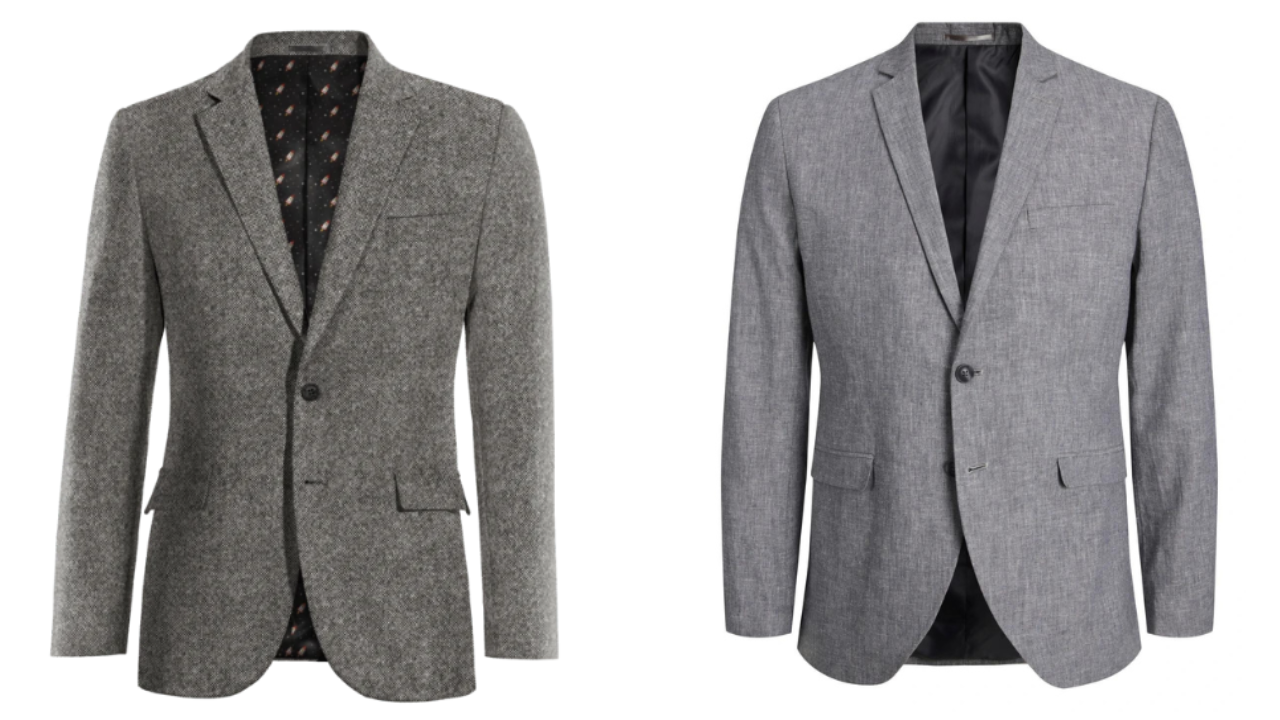
Blazer Fabric Weights by Season:
Year-Round:
Opt for a heavier, textured wool fabric for durability and versatility.
Recommended weight: 8–10 ounces, depending on your climate.
Fall & Winter:
Go for thicker wool fabrics like Harris Tweed.
Warmth: Keeps you cozy in colder months.
Weight Pairing: Complements heavier fabrics like wool trousers, sweaters, and ties.
Durability: Tighter weaves repel water and snow while lasting longer.
Ideal weight: 12–20 ounces, based on your needs.
Spring & Summer:
Choose lighter fabrics for breathability in hotter months.
Typical weight: 6 ounces for a breezy option.
Note: Heavier blazers are often a better choice due to their wider versatility and easier maintenance, as lightweight fabrics can be delicate and harder to care for.
Colors and Patterns
Colors
If you're choosing just one blazer, navy or charcoal are the best options. These timeless and versatile shades pair well with almost any outfit. For maximum flexibility, owning both is ideal.
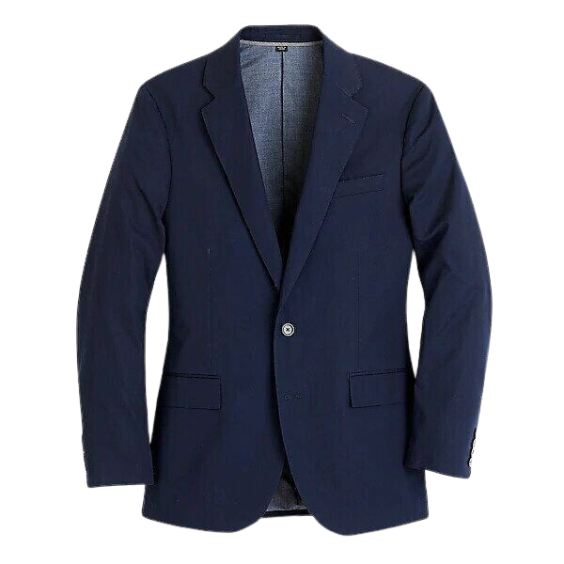
Navy
This looks great paired with white, blue, or brown items and accessories, including shoes.
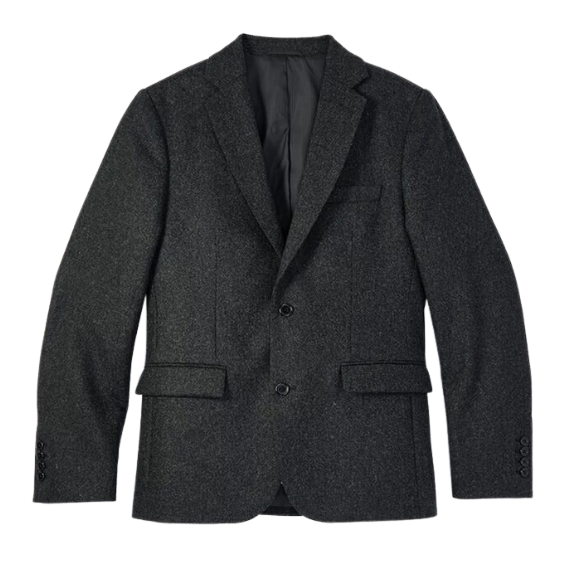
Charcoal Gray
This looks great paired with whites or blacks and any black accessories and shoes you have.
Patterns

Herringbone
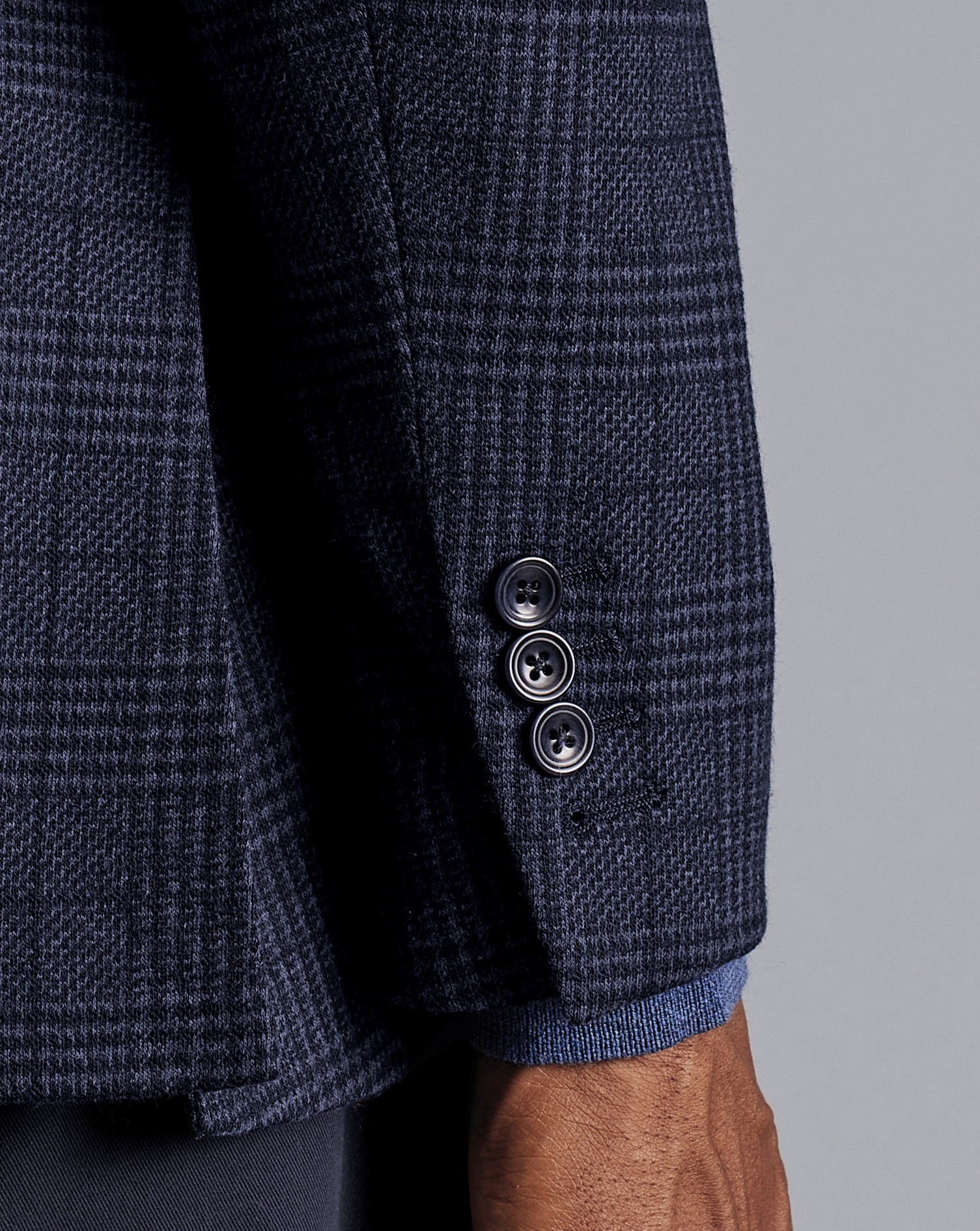
Plaid
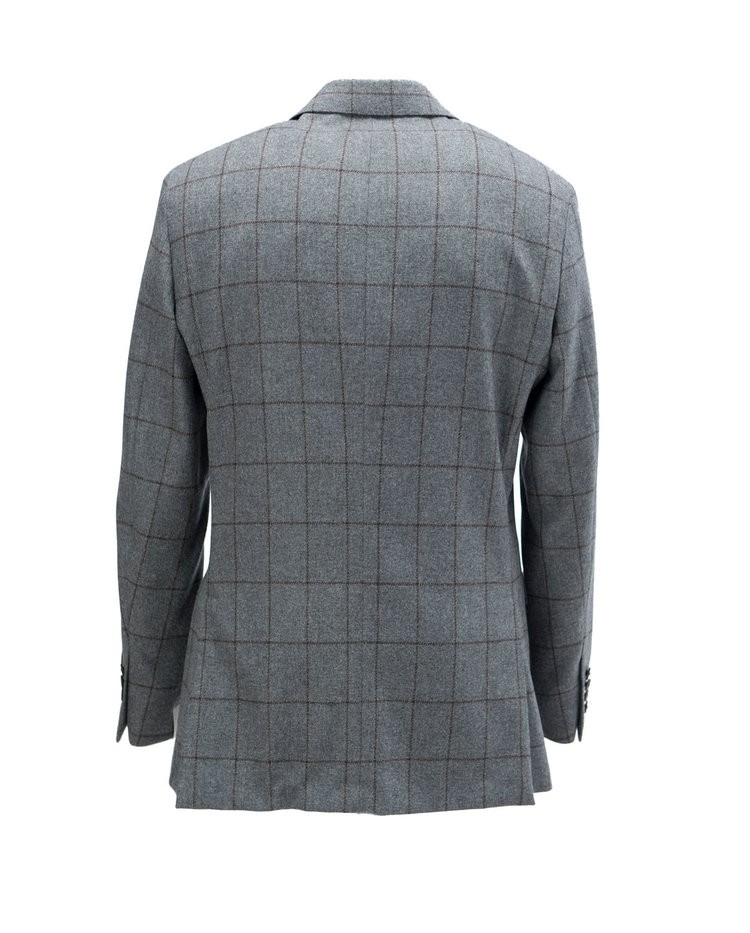
Windowpane
For Fall and Winter blazers, bolder and heavier patterns add style and character while pairing perfectly with seasonal wardrobe items. Recommended patterns include:
Herringbone: A classic, textured look.
Plaids: Timeless and versatile.
Windowpane: Works for both cold-weather and year-round wear.
These patterns complement heavier fabrics like wool trousers and sweaters, enhancing your cold-weather wardrobe.
Blazer Sizing
Blazers are sized differently from other wardrobe items. Instead of general sizes (S, M, L), they are labeled with a number and a letter (e.g., 38R), which provide two key details:
Number: Indicates chest size in inches (usually an even number between 34–52).
Letter: Denotes jacket length:
S (Short): For men 5'7" or shorter with a chest size between 36–46.
R (Regular): For men between 5'7" and 6'1" with a chest size between 36–54.
L (Long): For men 6'2" and taller.
Pro Tip: Blazer sizing can vary by brand, so always try on the jacket when possible to ensure the best fit.
How a Blazer Should Fit
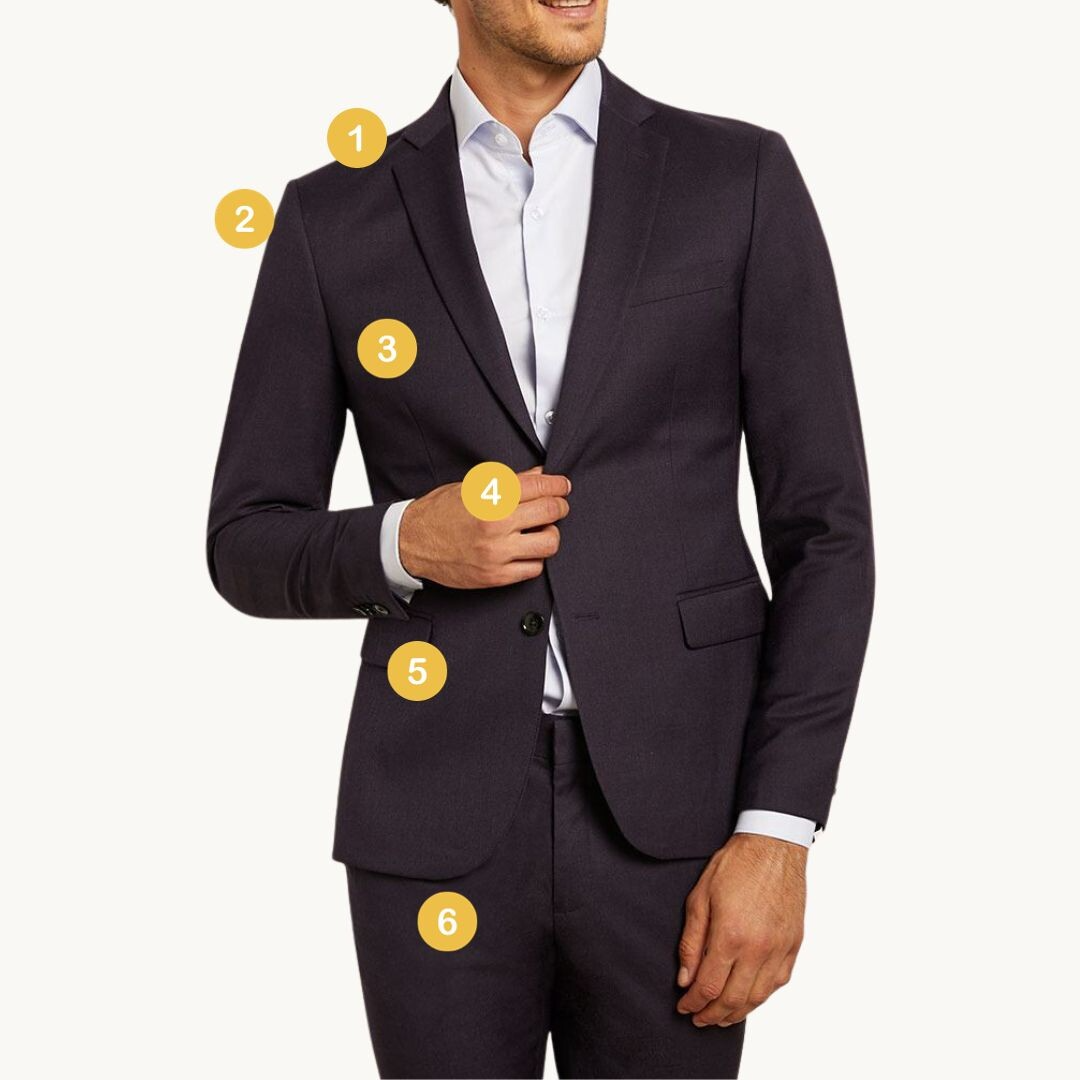
Collar: should rest against your shirt collar, touching the back of your neck without gaps.
Shoulder: seam should end where your shoulder slopes down to the arm, with no divots or wrinkles.
Armholes: should be high enough to allow mobility without cutting into the armpits.**
Body: with the top button fastened, body should lightly hug the torso without feeling tight.*
Sleeves: should end just before the wrist, stopping ¼ inch short when the hand is bent upward.
The hem should hit around the mid-crotch for men under 5'9" (1.79m) and lower crotch for taller individuals.
* Cheap & easy to tailor.
** Expensive & hard to tailor. Find a brand that fits better off the rack.
Perfect Fit & Outfit
A great-fitting blazer is just the start. The Essentials App gives you outfit formulas to make styling effortless for every occasion, specifically for your age, height, body type and skin tone.
Outfit Ideas
Elevated Casual

Charcoal Blazer
Heather Gray Crewneck Sweater
Tan Chinos
White Low-Top Sneakers
This look shows how a good blazer can really elevate even the most casual of everyday looks. If you're looking for something dressier, feel free to swap out the chinos for jeans and the gray sweater for a black version.
Want to see more blazer outfits that will work for different dress codes?
Business Casual
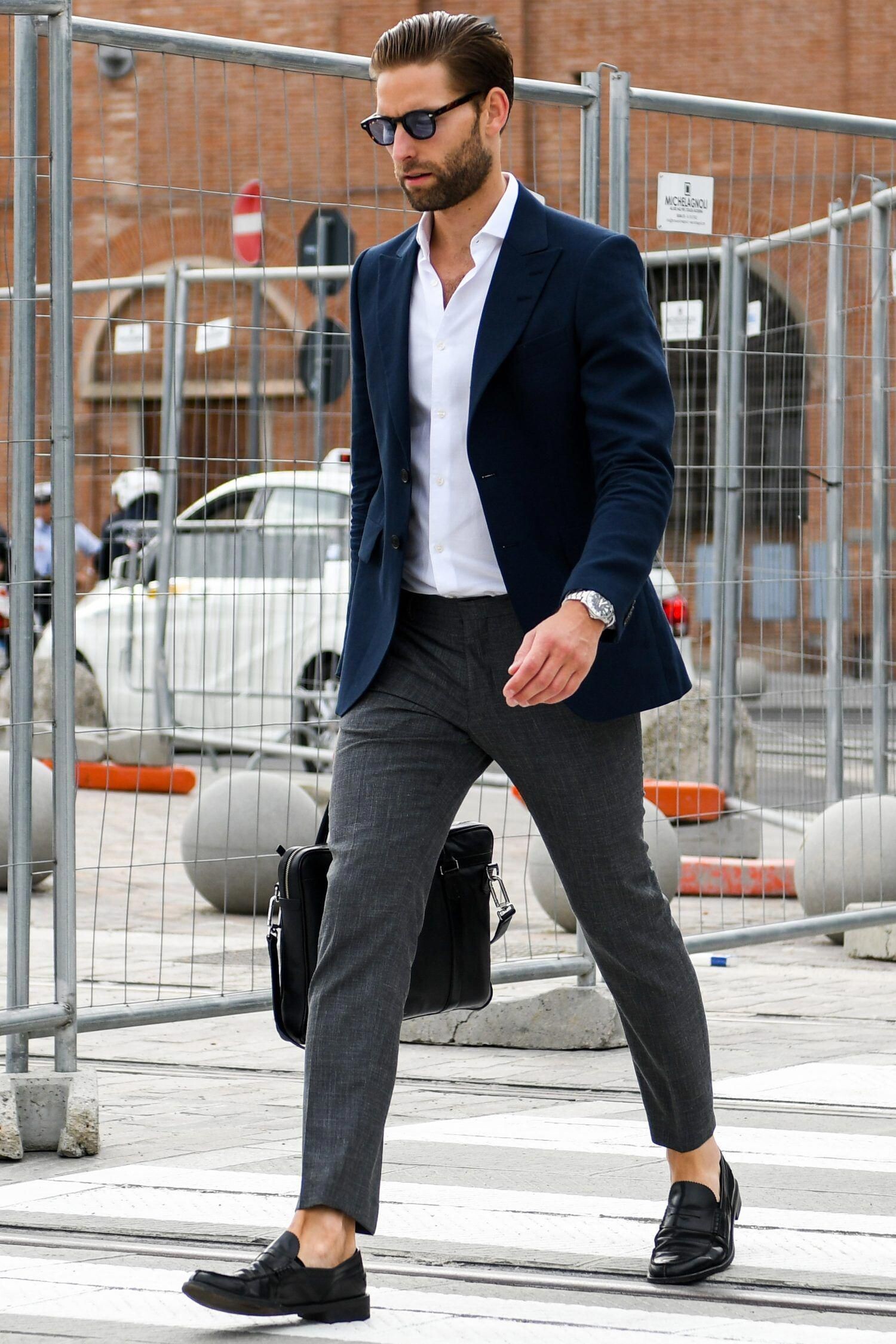
Navy Blazer
White Dress Shirt
Charcoal Wool Trousers
Black Penny Loafers
If you've heard that navy and black don't mix, please disregard that. It's nonsense. You can also swap in some of your black or brown dress shoes here and it will look just as good.
Your Style, Simplified
Take the guesswork out of styling with The Essentials App. Get expert outfit formulas, fit guidance, and shopping recommendations based on your age, height, body type and skin tone —all in one place.
